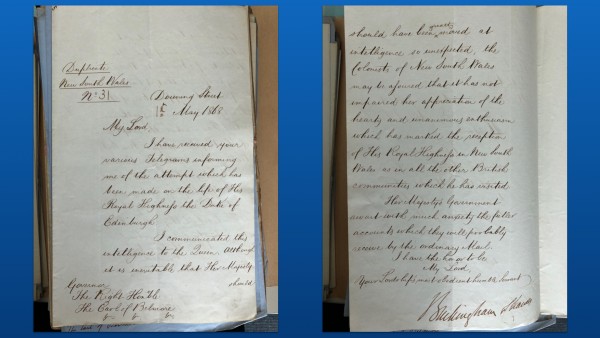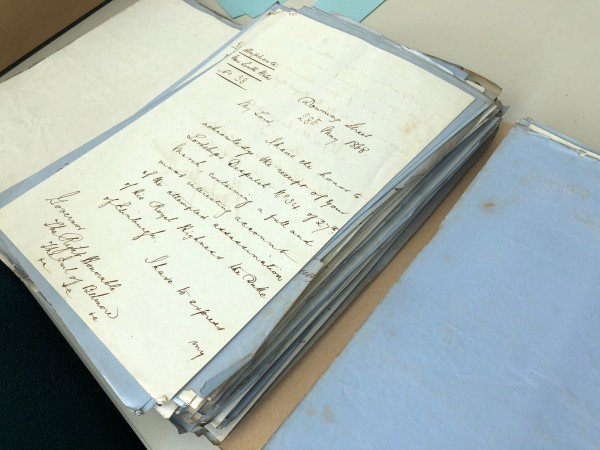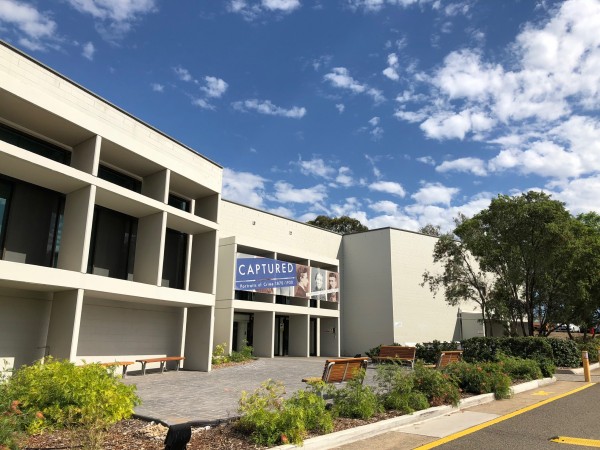150 Years on – The Story of Australia’s First Attempted Political Assassination

1st May 1868 - Letter from The Duke of Buckingham and Chandos, Secretary of State for the Colonies [1], acknowledging receipt of the Telegrams from the Earl of Belmore – 13th Governor of New South Wales – informing of the attempted assassination of His Royal Highness, Prince Alfred KG, Duke of Edinburgh in Sydney
Image: Courtesy of the State Archives and Records Authority of New South Wales
The first Royal Tour to Australia was also the occasion of our nation’s first attempted political assassination, during the visit of His Royal Highness, Prince Alfred, Duke of Edinburgh, second son of Queen Victoria.
In anticipation of his world tour and State visits, in 1867, Prince Alfred set sail in command of the steam frigate HMS Galatea, stopping in Brazil to meet the Emperor before arriving at the ports of Adelaide, Melbourne, Hobart, Brisbane and Sydney.
Receiving an enthusiastic welcome in Sydney, the Duke attended a public picnic in his honour at Clontarf, on 12 March 1868, a fundraising event for the Sydney Sailors’ Home.
During the picnic, an Irish Fenian supporter, Henry James O’Farrell, fired a pistol at close range at the Prince, who received a bullet wound to the back. It is reported the Prince fell to his knees, exclaiming: “Good God, my back is broken.”
O’Farrell escaped a lynching by the crowd, prior to being arrested. The Prince’s wounds were treated by the newly arrived Superintendent of Sydney Hospital, reportedly following initial attendance to his wounds at Government House.
Convicted of attempted murder, and hanged soon after on 21 April at Darlinghurst Gaol, clemency had been refused to O’Farrell, despite evidence of mental instability, and the Prince’s own proposal to refer O’Farrell’s sentence to Her Majesty.
Fortunately, His Royal Highness recovered completely by the end of March and set sail for England in early April, arriving home on 26 June 1868.
In the meantime, the telegrams advising of the attempt on the Prince’s life had arrived in Downing Street.
The Duke of Buckingham and Chandos replied: “I communicated this intelligence to the Queen. Although it is inevitable that Her Majesty should have been greatly moved at intelligence so unexpected, the Colonists of New South Wales may be afoured[2] that it has not impaired her appreciation of the hearty and unanimous enthusiasm which has marked the reception of His Royal Highness in New South Wales as in all the other British communities he has visited. Her Majesty’s Government await with much anxiety the fuller accounts which they will probably receive by the ordinary Mail.”
From an act of terror, a beneficial outcome was to follow. The citizens of New South Wales opened a fund for a new hospital, as a memorial and a thanksgiving to the Prince’s safe recovery – ‘The Prince Alfred Hospital’, later to be named ‘Royal Prince Alfred Hospital’ in Camperdown.

A folio of correspondence from that period held at State Archives, Kingswood.

The State Archives and Records Authority of New South Wales.
[1] Richard Plantagenet Campbell Temple-Nugent-Brydges-Chandos-Grenville, 3rd Duke of Buckingham and Chandos, served as the Secretary of State for the Colonies from 1867 to 1868.
[2]“afoured” is an old English term which means “assured”